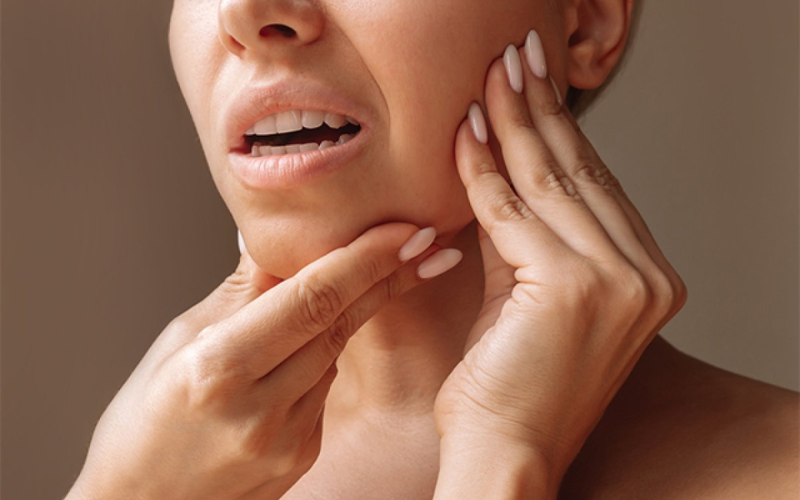Going through jaw discomfort can significantly impact daily life, making simple actions like speaking, chewing, or yawning challenging. This guide offers a comprehensive overview of jaw pain and temporomandibular joint (TMJ) disorders, including their symptoms, causes, and effective management strategies.
What Are TMJ Disorders?
The temporomandibular joint (TMJ) connects the jawbone to the skull, facilitating essential movements such as chewing and speaking. Disorders affecting this joint can lead to symptoms like:
- Jaw pain or tenderness.
- Difficulty or discomfort while chewing.
- Clicking, popping, or grating sounds during jaw movement.
- Locking of the jaw joint.
- Headaches or earaches.
These symptoms can disrupt daily activities and diminish overall quality of life.
Common Causes of TMJ Pain
Several factors can contribute to TMJ disorders, including:
- Teeth Grinding (Bruxism): Chronic grinding or clenching can strain the TMJ and surrounding muscles.
- Jaw Injury: Trauma to the jaw or head can damage the joint.
- Arthritis: Conditions like osteoarthritis or rheumatoid arthritis can affect the TMJ.
- Stress: More stress may lead to muscle tension and jaw clenching.
- Misalignment: Improper alignment of teeth or jaw can place undue stress on the TMJ.
Identifying the root cause is crucial for effective treatment.
Diagnosing TMJ Disorders
A thorough evaluation is essential for accurate diagnosis. Healthcare providers may:
- Review Medical History: Discuss symptoms and potential contributing factors.
- Physical Examination: Assess jaw movement, listen for sounds, and check for areas of discomfort.
- Imaging Studies: Utilize X-rays, MRI, or CT scans to examine joint structure and identify abnormalities.
Advanced imaging techniques can provide detailed insights into the joint’s condition.
Non-Invasive Treatment Options
Initial management often involves conservative approaches, such as:
- Lifestyle Modifications: Adopting a soft-food diet, avoiding extreme jaw movements, and practicing stress-reduction techniques.
- MYO therapy: Using targeted muscle relaxation techniques, MYO Therapy alleviates tension and improves the function of the jaw and surrounding muscles.
- Physical Therapy: Engaging in exercises to strengthen jaw muscles and improve mobility.
- Oral Appliances: Using splints or mouthguards to prevent teeth grinding and reduce strain on the TMJ.
- Medications: Taking pain relievers, anti-inflammatories, or muscle relaxants as prescribed to alleviate discomfort.
These methods aim to relieve symptoms and address contributing factors without invasive procedures.
Advanced Treatment Approaches
If symptoms persist, more advanced interventions may be considered:
- Dental Corrections: Adjusting bite alignment through orthodontics or restorative procedures.
- Injections: Administering corticosteroids or botulinum toxin to reduce inflammation and muscle tension.
- Surgical Options: In severe cases, procedures like arthrocentesis, arthroscopy, or open-joint surgery may be necessary.
These treatments are typically reserved for cases where conservative measures have been ineffective.
Preventive Measures
To minimize the risk of developing TMJ disorders or prevent recurrence:
- Maintain Good Posture: Proper alignment reduces strain on jaw muscles.
- Manage Stress: Incorporate relaxation techniques to decrease jaw clenching.
- Avoid Harmful Habits: Refrain from chewing gum excessively or biting on hard objects.
- Regular Dental Check-Ups: Ensure early detection and management of dental issues that could affect the TMJ.
Implementing these strategies can promote long-term jaw health.
Seek Professional Care
If you feel constant jaw pain or dysfunction, consult our dental professional specializing in TMJ disorders. They can provide a personalized treatment plan tailored to your specific needs, aiming to alleviate discomfort and restore optimal jaw function. Addressing TMJ disorders promptly will surely enhance your lifestyle choices and prevent further complications.

